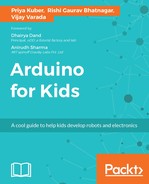It is well known that early childhood experiences shape adult life. Hobbies have now transitioned from simple Lego buildings to well researched knowledge building toolkits. Albert Einstein said, If you can't explain to a six year old, you don’t understand it yourself. This book is the attempt of 3 self-taught professional hobbyist-inventors to use their experience, to teach complex electronics to a 9-12 year old. This book contains the combined teaching experience of approximately 300 workshops conducted by 3 of the authors separately.
Learning, is a process, but effective learning is a skill. In this book, we have started with the fundamentals of critical thinking that all professional engineers use and translated it, to the level of children. We have ensured that the learning curve is relatable and includes the fundamentals of developing the research mindset, that is required in today’s career, irrespective of their life choices.
We also took care of increasing the complexity level of the projects to a level, just within the reach of kids. Irrespective of their technical level, adults can use this book to build projects and bond with their kids. The components used are simple and easy to find in any market.
The time taken to complete each project, has also been carefully crafted to last 1 day. The assumption is that you can have productive fun with your kids for several weekends. Each project has also been kept independent from the other, to give a sense of completion and tangible accomplishment to the kids.
This world will need more engineers, designers, astronauts, story tellers, and visionaries. We hope that this book is going to be the first step in their scientific and creative journeys.
Chapter 1, The World Around Us, is about explicitly drawing the attention of the reader to the systems and processes around us, encouraging the reader to take notes and observations. Children are inspired by everyday things more than an abstract concept. Every system is split into sensor-microcontroller-actuator.
Chapter 2, Systems and Logic, proceeds to teach the young readers how logic works. Starting from simple algorithms, it teaches the child to reach complex systems by first creating simple substitute systems. For example, to make an alarm, this chapter first teaches them to prototype using an LED. Then later teach them to add a button to disable the alarm, and as a challenge, would ask them to make a special combination lock in the activity.
Chapter 3, Components and Connections, is about the basics of electronics and building blocks of circuits. The child will also get introduced to basic sensors that are available off the shelf, also will learn the logic of the sensors, to enable them to create their own. They learn the concept of electricity, current, and voltages and understand that they can be manipulated.
Chapter 4, The Magic Wand, is about introducing Arduino as the 'brain' of a system and will teach students how to operate. It teaches a child to set up the Arduino with vibrant picture instructions. It will introduce them to a set process of thinking an execution when solving problems or working with projects. This chapter will also talk about open source, and open source hardware - will talk about how open source has revolutionized technology., giving them a non-selfish view about technology.
Chapter 5, Hello world!, is the beginning of integration of all the knowledge that the readers have accumulated and write their first program in Arduino and create a light sensitive organism.
Chapter 6, Safety box, begins with the series of projects. Every child likes to keep secrets and what better a first project than getting the child to make a small safety box that will ring an alarm if opened. The project further includes a button to stop the alarm, and further guides the child to set a secret key code to stop the alarm.
Chapter 7, Make a friend. is about teaching the child learning the importance of making a friend by using proximity sensor. When the child brings a friend near to his/her toy friend , the toy’s smile lights up. The child’s toy would be made using playdough, with the proximity sensor as a belt.
Chapter 8, Save Energy, aims to show the child the positive impact that a sensor-based smart system can have on the environment. The system uses a simple LDR (light dependent resistor) , an Arduino and an LED. This is to demonstrate a simple porchlight turning automatically off when it is daytime, thus saving energy.
Chapter 9, High 5!, creates a very gratifying High-5ing robot to celebrate the child's accomplishment so far through the book. It combines sensors and actuators and gives the child a comprehensive understanding of building autonomous systems. You build a robot that High 5s you when you are close!
Chapter 10, Plant, Meet Arduino, is a fun and a challenging activity where the child will make a plant more interactive. The child will build a system that can find out if the plant is thirsty and intimate human about it.
